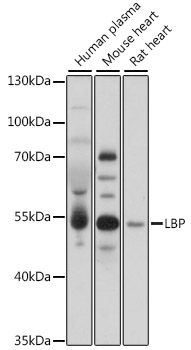Cell Biology Antibodies 13
Anti-LBP Antibody (CAB17507)
- SKU:
- CAB17507
- Product Type:
- Antibody
- Reactivity:
- Human
- Reactivity:
- Mouse
- Reactivity:
- Rat
- Host Species:
- Rabbit
- Isotype:
- IgG
- Antibody Type:
- Polyclonal Antibody
- Research Area:
- Cell Biology
Description
| Antibody Name: | Anti-LBP Antibody |
| Antibody SKU: | CAB17507 |
| Antibody Size: | 20uL, 50uL, 100uL |
| Application: | WB IHC |
| Reactivity: | Human, Mouse, Rat |
| Host Species: | Rabbit |
| Immunogen: | Recombinant fusion protein of Human LBP. |
| Application: | WB IHC |
| Recommended Dilution: | WB 1:500 - 1:2000 IHC 1:50 - 1:100 |
| Reactivity: | Human, Mouse, Rat |
| Positive Samples: | Human plasma, Mouse heart, Rat heart |
| Immunogen: | Recombinant fusion protein of Human LBP. |
| Purification Method: | Affinity purification |
| Storage Buffer: | Store at -20°C. Avoid freeze / thaw cycles. Buffer: PBS with 0.02% sodium azide, 50% glycerol, pH7.3. |
| Isotype: | IgG |
| Sequence: | Email for sequence |
| Gene ID: | 3929 |
| Uniprot: | P18428 |
| Cellular Location: | |
| Calculated MW: | 53kDa |
| Observed MW: | 53kDa |
| Synonyms: | BPIFD2, LBP |
| Background: | The protein encoded by this gene is involved in the acute-phase immunologic response to gram-negative bacterial infections. Gram-negative bacteria contain a glycolipid, lipopolysaccharide (LPS), on their outer cell wall. Together with bactericidal permeability-increasing protein (BPI), the encoded protein binds LPS and interacts with the CD14 receptor, probably playing a role in regulating LPS-dependent monocyte responses. Studies in mice suggest that the encoded protein is necessary for the rapid acute-phase response to LPS but not for the clearance of LPS from circulation. This protein is part of a family of structurally and functionally related proteins, including BPI, plasma cholesteryl ester transfer protein (CETP), and phospholipid transfer protein (PLTP). [provided by RefSeq, Apr 2012] |
| UniProt Protein Function: | LBP: Binds to the lipid A moiety of bacterial lipopolysaccharides (LPS), a glycolipid present in the outer membrane of all Gram-negative bacteria. The LBP/LPS complex seems to interact with the CD14 receptor. Belongs to the BPI/LBP/Plunc superfamily. BPI/LBP family. |
| UniProt Protein Details: | Protein type:Secreted, signal peptide; Secreted Chromosomal Location of Human Ortholog: 20q11.23 Cellular Component: extracellular space; cell surface; extracellular region Molecular Function:protein binding; lipopolysaccharide binding; receptor binding Biological Process: positive regulation of tumor necrosis factor biosynthetic process; detection of molecule of bacterial origin; positive regulation of toll-like receptor 4 signaling pathway; positive regulation of interleukin-6 production; response to lipopolysaccharide; negative regulation of tumor necrosis factor production; positive regulation of tumor necrosis factor production; defense response to Gram-negative bacterium; leukocyte chemotaxis during inflammatory response; positive regulation of chemokine production; positive regulation of interleukin-8 production; lipopolysaccharide transport; defense response to Gram-positive bacterium; macrophage activation during immune response; lipopolysaccharide-mediated signaling pathway; toll-like receptor signaling pathway; acute-phase response; innate immune response; cellular defense response; opsonization; toll-like receptor 4 signaling pathway; positive regulation of macrophage activation |
| NCBI Summary: | The protein encoded by this gene is involved in the acute-phase immunologic response to gram-negative bacterial infections. Gram-negative bacteria contain a glycolipid, lipopolysaccharide (LPS), on their outer cell wall. Together with bactericidal permeability-increasing protein (BPI), the encoded protein binds LPS and interacts with the CD14 receptor, probably playing a role in regulating LPS-dependent monocyte responses. Studies in mice suggest that the encoded protein is necessary for the rapid acute-phase response to LPS but not for the clearance of LPS from circulation. This protein is part of a family of structurally and functionally related proteins, including BPI, plasma cholesteryl ester transfer protein (CETP), and phospholipid transfer protein (PLTP). [provided by RefSeq, Apr 2012] |
| UniProt Code: | P18428 |
| NCBI GenInfo Identifier: | 116242615 |
| NCBI Gene ID: | 3929 |
| NCBI Accession: | P18428.3 |
| UniProt Secondary Accession: | P18428,O43438, Q92672, Q9H403, Q9UD66, B2R938, |
| UniProt Related Accession: | P18428 |
| Molecular Weight: | 53,384 Da |
| NCBI Full Name: | Lipopolysaccharide-binding protein |
| NCBI Synonym Full Names: | lipopolysaccharide binding protein |
| NCBI Official Symbol: | LBP |
| NCBI Official Synonym Symbols: | BPIFD2 |
| NCBI Protein Information: | lipopolysaccharide-binding protein; LPS-binding protein; BPI fold containing family D, member 2 |
| UniProt Protein Name: | Lipopolysaccharide-binding protein |
| Protein Family: | Lipopolysaccharide-binding protein |
| UniProt Gene Name: | LBP |
| UniProt Entry Name: | LBP_HUMAN |







